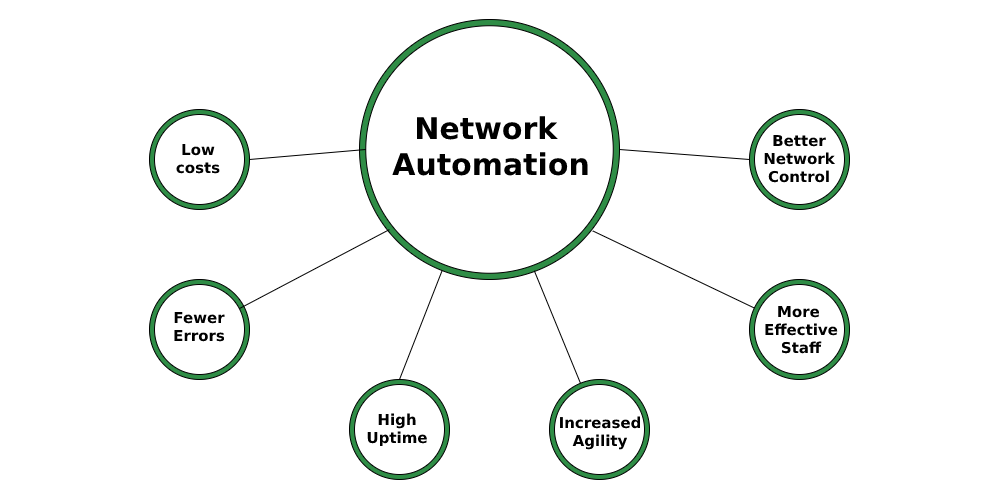
The Network Evolution: Traditional vs. Automated Infrastructure
Discover the revolution from traditional to automated network infrastructures, learn the benefits, challenges and advanced strategies for seamless transition.
Dev Orbit
July 14, 2025
The Network Evolution: Traditional vs. Automated Infrastructure
In an era where business agility and operational efficiency determine survival, understanding the evolution of network infrastructure is crucial. This article delves into the transformation from traditional setups to automated infrastructures, highlighting the implications and advancements that drive this change.
Introduction
As organizations increasingly rely on digital solutions, traditional network infrastructures often reveal their limitations: scalability issues, manual configuration errors, and prolonged downtimes. In this landscape, automated infrastructures emerge as a game-changer, empowered by technologies like AI and network automation tools. Understanding these shifts is pivotal for IT leaders navigating complexity and striving for efficiency. In this article, we promise to unravel the intricacies of this network evolution and equip you with actionable insights to optimize your organization's infrastructure.
Understanding Traditional Network Infrastructure
Traditional network infrastructure has been the backbone of IT environments since the dawn of networking. It encompasses hardware components such as routers, switches, firewalls, and various physical connections that bind them together. Companies operated in a mode where each piece of infrastructure was managed manually, creating a series of distinct challenges and limitations.
Manual Configuration: Every change required manual intervention, which increased the potential for human error.
Slower Scaling: Scaling up usually involved physically adding or replacing hardware, which could be time-consuming and costly.
Lack of Visibility: Monitoring tools were often insufficient, leading to decreased performance or unnoticed security threats until too late.
Furthermore, traditional infrastructures often lacked the agility to respond to changing business needs. Applications running on these environments were static, leading to inefficacies and downtime. As businesses embrace digital transformation, the constraints of traditional infrastructures have become increasingly evident, thus paving the way for automated solutions.
The Rise of Automated Infrastructures
Automated infrastructures bring a revolutionary perspective to network management. By leveraging software-driven solutions, organizations can deploy, configure, and manage resources without the extensive manual labor required in traditional systems. Here’s how this shift manifests:
Software-Defined Networking (SDN): This innovation decouples the control plane from the data plane, allowing administrators to manage network services through abstraction layers.
Network Function Virtualization (NFV): NFV brings in an agile architecture by replacing dedicated hardware with virtual servers, fostering flexibility and efficiency.
Automation Tools: Advanced automation tools like Ansible, Puppet, and Terraform streamline the process of managing resources, enabling infrastructure as code (IaC).
The implementation of automated infrastructures facilitates dynamic resource allocation, lowering operational costs while speeding up deployment times. Moreover, automation reduces the risk of human error, providing consistency in configuration and management processes.
Comparative Analysis: Traditional vs. Automated Infrastructure
Following the discussion of traditional and automated infrastructures, a direct comparison can provide clear insights into their capabilities and impact on businesses.
1. Scalability
Scaling a traditional network means physically adding new devices and reconfiguring existing ones, which can take weeks. In contrast, automated infrastructures facilitate seamless scaling through orchestration tools, allowing businesses to adapt in real-time as demands fluctuate.
2. Operational Agility
In traditional setups, responding to incidents can be slow. Automated infrastructures make use of predictive analytics and real-time monitoring, allowing for proactive responses to potential issues before they affect service delivery.
3. Cost Efficiency
The maintenance costs of traditional systems can accumulate quickly due to staffing needs and the complexity of equipment. Automated infrastructures reduce these costs by eliminating redundancy and optimizing resource utilization through automated scaling and provisioning.
4. Security
Security in traditional systems often relies on perimeter defenses and manual updates, making them vulnerable to rapidly evolving threats. Automated infrastructures, utilizing AI, enable real-time threat detection and response, significantly enhancing security posture.
5. Resource Management
Manual resource management in traditional networks leads to inefficiencies and inconsistencies. Automated solutions allow for continuous monitoring and management, ensuring resources are reallocated where they are most needed dynamically.
Real-World Examples of Network Evolution
The transition from traditional to automated networks is not theoretical; numerous organizations have successfully navigated this evolution. Consider the case of Bank of America, which adopted SDN to enhance its network's responsiveness. By implementing automated solutions, they reduced operational delays from two weeks to mere minutes when deploying network changes.
Similarly, Netflix deployed a highly automated hybrid cloud infrastructure to handle its growing customer base and streaming demands. Their ability to manage fluctuating demands resulted in improved viewer experiences and significant operational savings.
Challenges and Considerations in Transitioning to Automation
While the benefits of automation are compelling, transitioning to an automated infrastructure is not without its challenges. Organizations must approach this transition strategically.
Cultural Resistance: Shifting to automation often meets resistance from staff who fear job displacement. It is essential to foster a culture that embraces new technology as a partner rather than a threat.
Integration Complexities: Organizations must consider existing infrastructure and ensure automation tools can integrate seamlessly. Legacy systems may require tailored approaches or hybrid solutions.
Skill Gaps: A shortage of skilled professionals in automation tools can present barriers. Organizations should invest in training and upskilling existing staff to navigate this new terrain.
Bonus/Advanced Tips for Implementing Automated Infrastructures
1. Start Small
Begin with a specific segment of your infrastructure. This minimizes risks and allows you to analyze the outcomes without significant repercussions. Gradually expand the automation to other areas based on lessons learned.
2. Ensure Robust Monitoring Tools
Utilizing extensive monitoring tools is critical for troubleshooting and maintaining performance in an automated environment. Solutions such as Pingdom or Datadog can provide insights into your systems' health.
3. Document Everything
Comprehensive documentation of automated processes and configurations will aid in debugging and future development. This fosters transparency and operational consistency across teams.
4. Invest in Security Automation
Security should be embedded in every automation strategy. Tools like Cloudflare and Detectify can provide automated vulnerability scanning and incident response protocols.
5. Emphasize Continuous Learning
Encourage a culture of continuous learning within your IT team. Stay abreast of technology advancements and understand how they can further optimize your automated infrastructure.
Conclusion
The evolution from traditional to automated network infrastructures marks a significant shift in how organizations approach IT challenges. The shift not only drives efficiency but also cultivates agility and security in a world characterized by rapid change. By embracing automated infrastructures, organizations can unlock a wealth of opportunities, optimize their resources, and enhance overall performance. Now, we encourage you to reflect on these insights: how might they inform your organization's next steps? Share your thoughts, insights, or questions in the comments below, and don't forget to share this article with others who might benefit from understanding this evolution.

Enjoyed this article?
Subscribe to our newsletter and never miss out on new articles and updates.
More from Dev Orbit

Data Validation in Machine Learning Pipelines: Catching Bad Data Before It Breaks Your Model
In the rapidly evolving landscape of machine learning, ensuring data quality is paramount. Data validation acts as a safeguard, helping data scientists and engineers catch errors before they compromise model performance. This article delves into the importance of data validation, various techniques to implement it, and best practices for creating robust machine learning pipelines. We will explore real-world case studies, industry trends, and practical advice to enhance your understanding and implementation of data validation.

MongoDB Insights in 2025: Unlock Powerful Data Analysis and Secure Your Database from Injection Attacks
MongoDB powers modern backend applications with flexibility and scalability, but growing data complexity demands better monitoring and security. MongoDB Insights tools provide critical visibility into query performance and help safeguard against injection attacks. This guide explores how to leverage these features for optimized, secure Python backends in 2025.

The Labels First Sued AI. Now They Want to Own It.
In the rapidly evolving landscape of artificial intelligence, a fascinating shift is underway. Music labels, once adversaries of AI applications in the music industry, are now vying for ownership and control over the very technologies they once fought against. This article delves into the complexity of this pivot, examining the implications of labels seeking to own AI and how this transition could redefine the music landscape. If you’re keen on understanding the future of music technology and the battle for ownership in an AI-driven age, read on.

How to Build an App Like SpicyChat AI: A Complete Video Chat Platform Guide
Are you intrigued by the concept of creating your own video chat platform like SpicyChat AI? In this comprehensive guide, we will walk you through the essentials of building a robust app that not only facilitates seamless video communication but also leverages cutting-edge technology such as artificial intelligence. By the end of this post, you'll have a clear roadmap to make your video chat application a reality, incorporating intriguing features that enhance user experience.

Handling File Uploads Using Multer In Node Js Express
Web developers must understand how to handle file uploads in the fast-changing world of web development. Multer in Node.js is a robust solution for this task. This article explores Multer features, installation process, advanced functionalities and best practices for seamless integration with Express.

Deep Dive into Error Handling and Logging in Node.js
Mastering the essentials of error handling and logging in Node.js for more resilient backends.
Have a story to tell?
Join our community of writers and share your insights with the world.
Start Writing